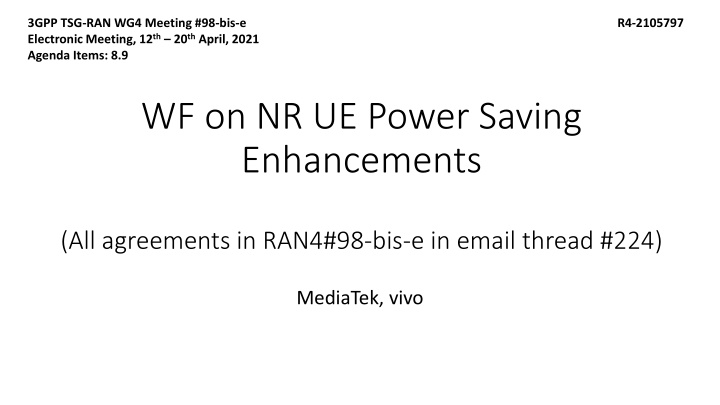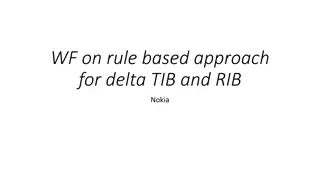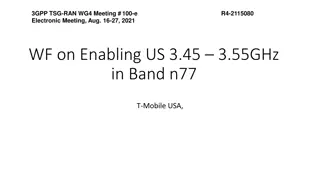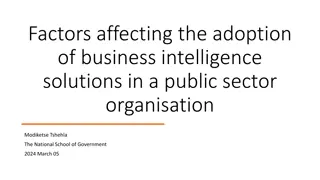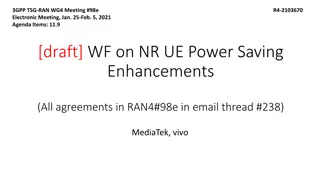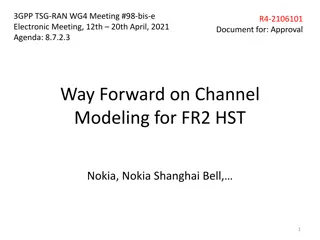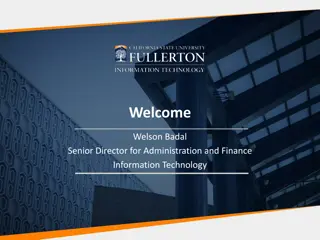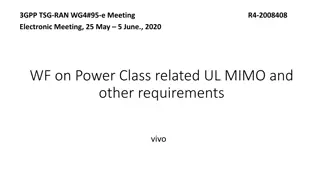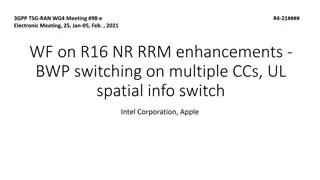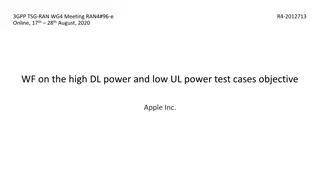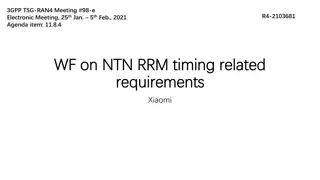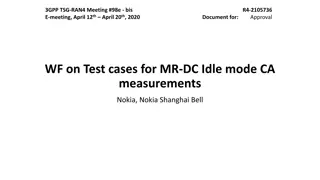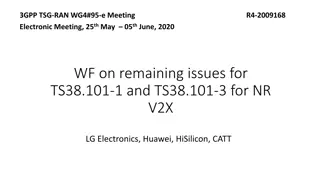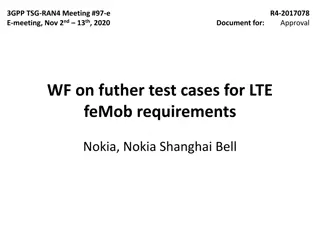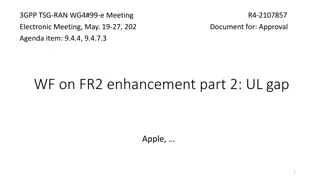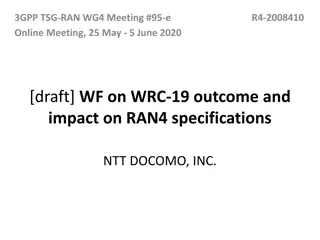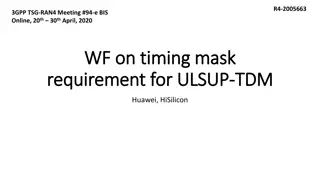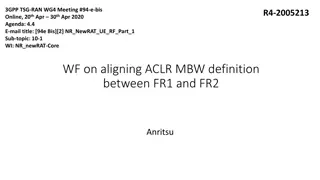RAN4 Meeting #98-bis-e Summary and Issues on NR UE Power Saving Enhancements
During the RAN4 Meeting #98-bis-e, discussions focused on various issues related to NR UE power saving enhancements. Topics included Applicable DRX cycles, relaxation factors, criteria for RLM/BFD relaxation, and low mobility criteria. Evaluations on RRM measurements and interaction between PDCCH and RLM/BFD relaxation were also highlighted. Feasible scenarios for relaxation were defined for different cases in FR1 and FR2, considering power saving gains and system-level impacts. The meeting emphasized the need for further assessment and analysis to determine the optimal relaxation requirements for R17 UE measurements.
Download Presentation

Please find below an Image/Link to download the presentation.
The content on the website is provided AS IS for your information and personal use only. It may not be sold, licensed, or shared on other websites without obtaining consent from the author.If you encounter any issues during the download, it is possible that the publisher has removed the file from their server.
You are allowed to download the files provided on this website for personal or commercial use, subject to the condition that they are used lawfully. All files are the property of their respective owners.
The content on the website is provided AS IS for your information and personal use only. It may not be sold, licensed, or shared on other websites without obtaining consent from the author.
E N D
Presentation Transcript
3GPP TSG-RAN WG4 Meeting #98-bis-e Electronic Meeting, 12th 20th April, 2021 Agenda Items: 8.9 R4-2105797 WF on NR UE Power Saving Enhancements (All agreements in RAN4#98-bis-e in email thread #224) MediaTek, vivo
General Issue 1-1: Issues to be further discussed in the work phase RAN4 should continue to work on the open issues in the work phase, including Applicable DRX cycles for relaxation The threshold value and/or margins based on further evaluations Relaxation factor determination Criteria of RLM/BFD relaxation (issue 2-3-1) Discuss the values of X and Y in good serving cell quality in RLM/BFD in issue 2-3-2. FFS: Discuss low mobility criteria of RLM/BFD in issue 2-3-5 if no agreement can be made at this meeting. Interworking between PDCCH relaxation and RLM/BFD relaxation as captured in issue 2-1-3. Other open issues are not precluded.
Evaluation assumption Issue 2-1-2: assumption on other RRM measurement Background for information: The guidance from RP-91-e, For Rel-17 WI of UE power saving enhancements for NR, no specification impact to RRM measurement procedure requirements and measurement performance requirements is expected. Note: in the feasibility study, Option 1: RRM measurement assumptions are kept unchanged compared to the earlier simulations used for defining the existing RRM measurement requirements. Option 2: Do not consider RRM measurement in feasibility study Issue 2-1-3: Impact on PDCCH monitoring RAN4 shall assess the interaction between PDCCH relaxation (as being discussed in RAN1) and RLM/BM relaxation (as being discussed in RAN4) from power consumption perspective once there is more progress in RAN1 on PDCCH relaxation.
Feasible scenarios for relaxation RAN4 conclude the feasible scenario and will define the RLM/BFD requirements for R17 UE measurements relaxation for RLM and/or BFD in work phase for the following cases, Case 1: SSB based RLM/BFD measurement relaxation in FR1 Case 2: CSI-RS based RLM/BFD measurement relaxation in FR1 FFS Case 3: CSI-RS based RLM/BFD measurement relaxation in FR2 FFS Case 4: SSB based RLM/BFD measurement relaxation in FR2 Note: UE is allowed but not mandatory to perform relaxed RLM/BFD measurements when the relaxation criteria is met in above feasible scenarios. For the feasible cases with positive power saving gain Option 1: When defining relaxation requirement, RAN4 should consider the maximum additional delay of RLF declaration within a confidence level due to power saving, i.e., the probability of maximum additional delay within x is larger than y, for power saving evaluation on different schemes. On the FFS case, further Considerations as bellows Option 1: Negative system level impact due to RLM/BFD relaxation should be minimized e.g. by studying the time of outage with different relaxation factors. Option 2: RAN4 needs to study whether the beneficial scenario is a reasonable case for network configuration.
Considerations on the conclusions of the feasibility study Considerations on the conclusions of the feasibility study Option 1: Negative system level impact due to RLM/BFD relaxation should be minimized e.g. by studying the time of outage with different relaxation factors. Option 1a: RAN4 should consider the maximum additional delay of RLF declaration within a confidence level due to power saving, i.e., the probability of maximum additional delay within x is larger than y, for power saving evaluation on different schemes. Option 2: RAN4 needs to study whether the beneficial scenario is a reasonable case for network configuration.
Issue 2-2-6: DRX cycle applicability Relaxation is applicable for DRX<=8040ms. FFS DRX of 80 ms FFS adjustment to other DRx cycles is needed to keep the monotonicity of DRx cycles w.r.t. evaluation time FFS Maximum relaxation factor should be related to DRX cycle and RS periodicity. Issue 2-2-7: Potential spec impact The spec impact of R17 power saving will be discussed in the work phase.
Relaxation criteria Issue 2-3-1: Criteria of RLM/BFD relaxation General whether relaxed RLM/BFD requirements can be applied depends on both the serving cell quality and UE mobility state FFS the precise and robust metric for serving cell quality and UE mobility state Issue 2-3-2/2-3-3/2-3-4: Good serving cell quality criteria of RLM/BFD relaxation Good serving cell quality criteria of RLM/BFD relaxation is defined as the radio link quality is better than a threshold. FFS radio link quality > Qout + X (dB) for RLM FFS radio link quality > Qout,LR + Y (dB) for BFD relaxation. FFS how to derive the values of X, Y The radio link quality in good serving cell quality criteria for R17 RLM/BFD relaxation is based on SINR FFS how to define the metric of SINR derive the corresponding SINR level of the threshold used in good serving cell quality criteria FFS which SINR is used Option 1: Reuse SINR for RLM/BFD evaluation FFS whether RSRP is also needed for BFD as additional condition FFS: The thresholds are configured or pre-defined. FFS: Different threshold configuration (i.e. different IEs in RRC signaling )for SSB based and CSI-RS based RLM/BFD is allowed
Relaxation factors FFS on following: Option 1: Evaluation period based on fixed sample number The relaxation factor is implicitly defined, similar to the beam sweeping factor implicitly defined in FR2 RRM measurement requirements. Option 2: Evaluation period scaling with the relaxation factor The relaxation factor is explicitly defined FFS whether Different relaxation factors between FR1 and FR2 FFS whether Different relaxation factors for different SINR range FFS whether Different relaxation factors for SSB and CSI-RS FFS What UE speed is used as reference for derving the relaxation factor Option 3: Up to UE implementation as long as the additional delay for RLM/BFD declaration is within the (to be defined) relaxed requirement Other options are not precluded.
Issue 2 Issue 2- -3 3- -5: Low mobility criteria of RLM/BFD relaxation 5: Low mobility criteria of RLM/BFD relaxation Low mobility scenario under which the UE is allowed to apply the RLM/BM requirements is determined and configured to UE by the network, and it is up to the UE whether to apply relaxed RLM/BM requirements when configured. Given the this feature is enabled by the network, the low mobility criterion is defined based on FFS until RAN4 #99e Option A: UE will need to keep verifying whether the low mobility criterion is fulfilled based on the channel condition Option A1: RSRP variation (reuse R16 low mobility criterion and procedure) Option A2: SINR variation Option B: UE will not need to keep verifying whether the low mobility criterion is fulfilled based on the channel condition Option B1: UE assumes the low mobility criterion is fulfilled (e.g. fixed UE) or not fulfilled (e.g. vehicular UE). Option B2: Network configured whether the low mobility criterion is fulfilled or not Low mobility scenario under which the UE is allowed to apply the relaxed RLM/BM requirements is determined and configured to UE by the network, and it is up to the UE whether to apply relaxed RLM/BM requirements when configured Option C: The low mobility criterion can be left for RAN2 to decide. Send LS to RAN2 to trigger RAN2 discussion. Option D: Other options on how often UE verifies the low mobility criterion is open for discussions at next meeting. If no consensus can be achieved in RAN4 #99e, RAN4 move forward with option C, i.e. send LS to RAN2
Issue 2 Issue 2- -3 3- -6: Exiting criteria of RLM relaxation 6: Exiting criteria of RLM relaxation Background: Following agreement was made at last meeting [R4-2103670]: The UE while performing relaxed RLM upon detecting certain number of out-of-sync indications or upon triggering T310 or upon observed link quality degradation or mobility state change reverts to the normal RLM operation (i.e. without relaxation). Following additional options are listed below: FFS which of the following options can be used as the exiting criteria of RLM relaxation Option 1: exit relaxation mode when any relaxation criterion is not met Option 1a: a hysteresis value (e.g. 3dB) could be used to avoid ping-ping effect. Relaxation exiting condition: Qualitymeasured + Hys < Thresh Option 2: exit relaxation mode when the radio link quality is worse than a certain SINR threshold Thexit, which is higher than Qout. Option 2a: set different radio link quality threshold for entering and exiting the relaxation Option 2b: either the averaged SINR based on reduced number of samples is below Thexit, or the one-shot SINR is below Qout. Option 3: exit relaxation mode based on out-of-sync indication. Option 3a: exit when N310 starts to count, i.e. 1 out-of-sync indication. Option 3b: exit when T310 is running witch is triggered by a new counter Option 3c: exit when certain number of out-of-indications Option 3d: exit when certain consecutive out-of-sync indications Option 4: Additional time is allowed for UE to evaluate first OOS indication when UE is in power saving mode. UE is in normal mode after first OOS indication. The additional delay for RLF declaration is guaranteed to be within OOS evaluation time (TEvaluate_out_SSB) in normal mode. Relaxation factor and exit SINR threshold (for good cell quality condition) is up to UE implementation, but the first OOS indication requirement has to be satisfied.
Issue 2 Issue 2- -3 3- -7: Exiting criteria of BFD relaxation 7: Exiting criteria of BFD relaxation FFS which of the following options can be used as the exiting criteria of BFD relaxation Option 1: exit relaxation mode when any relaxation criterion is not met Option 1a: a hysteresis value (e.g. 3dB) could be used to avoid ping-ping effect. Relaxation exiting condition: Qualitymeasured + Hys < Thresh Option 2: exit relaxation mode when the radio link quality is worse than a certain threshold Thexit , which is higher than Qout_LR. Option 2a: set different radio link quality threshold for entering and exiting the relaxation Option 2b: either the averaged SINR based on reduced number of samples is below Thexit, or the one-shot SINR is below Qout_LR. Option 3: exit relaxation mode based beam failure instance indication Option 3a: exit upon detecting the 1 beam failure instance indication. Option 3b: exit after BFI_COUNTER add to the value of a new counter or a new parameter, the new counter or the new parameter is configured by network. Other options are not precluded
Relaxation scheme Issue 2-4-1: Relaxed evaluation period of RLM/BFD Scaling factor defining the relaxed RLM/BFD evaluation period is defined based on max(TDRX, TSSB). FFS the following options Option 1:The similar definition of RLM/BFD evaluation period in Rel-15 can be reused as Max(T, Ceil([Y] x P x N) x Max(TDRX,TSSB)) Option 2: If power saving conditions are satisfied, allow TEvaluate_ps_out_SSB for the first OOS indication and the original TEvaluate_out_SSB doesn t apply Option 2a Option 2b Configuration no DRX DRX cycle 80ms TEvaluate_ps_out_SSB (ms) Max(200, Ceil(10 P) TSSB) Max(200, Ceil(30 P) Max(TDRX,TSSB)) Max(200, Ceil(20 P) Max(TDRX,TSSB)) Ceil(10 P) TDRX TSSB is the periodicity of the SSB configured for RLM. TDRX is the DRX cycle length. Configuration TEvaluate_ps_out_SSB (ms) Max(200, Ceil(10 P) TSSB) no DRX Max(200, Ceil(15 P) Max(TDRX,TSSB) + (K-1) Max(TDRX,TSSB)) DRX cycle 80ms 80ms<DRX cycle 320ms DRX cycle>320ms NOTE: Max(200, Ceil(15 P) Max(TDRX,TSSB)) 80ms<DRX cycle 320ms Ceil(10 P) TDRX DRX cycle>320ms NOTE: K is the relaxation factor. TSSB is the periodicity of the SSB configured for RLM. TDRX is the DRX cycle length, Option 3: modify the Rel-15 wording in the requirements as follows the new evaluation period TEvaluate_out_SSB-Relaxed is specified as K1* TEvaluate_out_SSB, where TEvaluate_out_SSB is as specified in clause 8.1.3.2 in TS 38.133 . the new indication period TIndication_interval-Relaxed is specified as K2* TIndication_interval where TIndication_interval is as specified in clause 8.1.6 in TS 38.133. FFS whether K1=K2 Other options are not precluded.
Issue 2-4-2: Are the parameters of relaxation criteria predefined or configurable The parameters of relaxation criteria can be configured by the network. Option 1: The relaxation criteria shall be configured by the network to the UE. If the threshold (criteria) is not configured, it means the UE cannot go into relaxation mode. Option 2: The parameters of relaxation criterion of low mobility and entering condition of good cell quality can be configured by the network. Exit condition of good cell quality is FFS. Option 3: The parameters used in good serving link quality criteria are predefined. FFS other potential parameters.
Issue 2-4-3: network or UE to determine the relaxation criteria is fulfilled or not UE determines whether the relaxation criteria can be fulfilled or not based on the relaxation criteria configured by the NW. Issue 2-5-4: Applicability for BFD relaxation requirement As the legacy BFD requirement, the BFD relaxation requirement is applicable for PCell, PSCell and all configured SCells. Issue 2-5-2/2-5-3 FFS whether to RAN4 introduce R17 RLM/BFD relaxation requirement in intra-band CA for the case that RLM on a SpCell and BFD on a Scell. Issue 2-5-2: Exiting relaxation mode in intra-band CA/DC For BFD in intra-band CA/DC, if UE meets the conditions of reverting to the normal BFD in one serving cell, it is expected the reversion operations are applied to other serving cell(s). Issue 2-5-3: Relaxation criteria in intra-band CA/DC For intra-band CA case, RAN4 to use the same RLM/BFD measurement relaxation criteria for the serving cells.
Relaxation in intra-band CA Issue 2-5-2: Exiting relaxation mode in intra-band CA/DC For intra-band CA, if UE has fulfilled the criterion for operating RLM/BFD in relaxed mode in one serving cell, then it is allowed to operate RLM/BFD in relaxed mode in all other serving cells if same type of RS are used for RLM/BFD in the serving cell and other serving cells. Issue 2-5-3: Relaxation criteria in intra-band CA/DC Option 1: For intra-band CA, if UE meets the conditions of reverting to the normal RLM/BFD in one serving cell, it is expected the reversion operations are applied to other serving cell(s) if same type of RS are used for RLM/BFD in the serving cell and other serving cells.
For information: Observations on the simulation results On power saving gain: Based on simulation results submitted for RAN4#98e and RAN4 #98-bis-e meeting, it can be observed that With FTP or VoIP model is considered, if L1 measurement intervals for RRM are also extended K times For FR1 SSB-based RLM/BFD relaxation with 40ms DRX cycle, at least 3 sources show that the power saving gain is 3.89% to 16.4% for K=2, 13.3% to 20.0% for K=4. For FR1 CSI-RS based RLM/BFD relaxation with 40ms DRX cycle, at least 1 source showS that the power saving gain is 4.49% to 6.80% for K=2, 13.41% to 20.34% for K=4 For FR2 CSI-RS based RLM/BFD relaxation with 40ms DRX cycle, at least 1 source shows that the power saving gain is 5.84% to 9.31% for K=2, 17.79% to 28.63% for K=4. For FR1 SSB-based RLM/BFD relaxation with 160ms DRX cycle, at least 1 source show that the power saving gain is 4.95% for K=2, 7.42% for K=4. By extending only RLM/BFD measurement interval without reducing RRM measurement samples within RRM measurement period At least 2 sources show minimal or no power saving gain. Note: Number of RRM measurement samples within RRM measurement period is up to UE implementations Therefore, it is concluded that the beneficial scenarios for R17 RLM BFD relaxation are When L1 measurement interval for RLM/BFD/RRM can be extended, i.e. number of samples can be reduced, which means SINR is high enough and mobility is low enough, and When FTP traffic or Voip traffic is considered, and When DRX cycle length is not longer than 80 ms, and It is more beneficial if PDCCH-WUS is configured
For information: Observations on the simulation results On mobility impact: Based on simulation results submitted for RAN4#98e and RAN4 #98-bis-e meeting, it can be observed that Regarding delta SINR, for FR1 SSB-based RLM OOS relaxation, when DRX cycle is not longer than 80ms with mobility of 3 km/h, at least 6 sources show that the delta SINR of max(5%, 95%) is 0.39 dB to 2.15 dB for K=2 , 0.8 dB to 3.02 for K=4, 1.35dB to 4.5dB for K=8. with mobility of 30 km/h, at least 3 sources show that the delta SINR of max(5%, 95%) is 1.05 dB to 2.42 dB for K=2 , 2.4 to 5.06 dB for K=4, 3.6 to 7.57 dB for K=8. Regarding delta SINR, for FR1 CSI-RS-based RLM OOS relaxation, when DRX cycle is not longer than 80ms with mobility of 3 km/h, at least 3 sources show that the delta SINR of max(5%, 95%) is 1.3 dB to 1.5 dB for K=2 , 1.75 dB to 2.08 dB for K=4. Regarding delta SINR, for FR2 CSI-RS-based RLM OOS relaxation, when DRX cycle is not longer than 40ms with mobility of 3 km/h, at least 2 sources show that the delta SINR of max(5%, 95%) is 1.1 to 3.2 dB for K=2 , 1.27 to 3.8 dB for K=4, 1.4 to 4.2 dB for K=8. Regarding delta SINR, for FR2 SSB-based RLM OOS relaxation, when DRX cycle is not longer than 80ms with mobility of 3 km/h, at least 2 sources show that the delta SINR of max(5%, 95%) is 1.1 to 1.7 dB for K=2 , 1.69 to 2.67 dB for K=4, 2.05 to 4.87 dB for K=8. Therefore, the feasible scenarios for R17 RLM and BFD relaxation are When DRX cycle length is not longer than 80 ms, and When SINR is above a proper threshold, and When UE mobility is below a certain speed. when mobility state is below 30km/h for FR1, or, when UE speed is less than 3km/h in FR2.
For information: Observations on the simulation results On mobility impact: Based on simulation results submitted for RAN4#98e and RAN4 #98-bis-e meeting, it can be observed that Regarding 95%-tile increased RLF latency, for FR1 SSB-based RLM OOS relaxation, when DRX = 40ms with mobility of 3 km/h, at least 2 sources show that the increased latency is less than 40ms for K=2, less than 120ms for K=4, and less than 280ms for K=8. The increase is less than 2.5% for K=2, less than 7.5% when K=4 and less than 17.5% when K=8, as T310 = 1000ms and N310 = 1. with mobility of 30 km/h, at least 2 sources show that the increased latency is less than 40ms for K=2, less than 120ms for K=4, and less than 280ms for K=8 with 95% probability. The increase is less than 2.5% for K=2, less than 7.5% when K=4 and less than 17.5% when K=8, as T310 = 1000ms and N310 = 1. Regarding averaged increased RLF latency, for FR1 SSB-based RLM OOS relaxation, at least 2 sources show that the averaged increased RLF latency are less than 0.02% for 3km/h mobility and 0.2% for 30km/h, when DRX is not longer than 80ms. Following observations were made based on simulation results submitted in R4-2106851 and analyzed in R4-2106852: Up to 3 km/h and at high SINR (in-sync), relaxation by factor 4 can be allowed for FR1. Up to 3 km/h at low SINR (out-of-sync), relaxation if allowed should be smaller than factor 2 for FR1. Up to 30 km/h and at high SINR (e.g. in-sync), relaxation if allowed should be smaller than factor 2 FR1. Up to 30 km/h at low SINR (e.g. out-of-sync), no relaxation shall be allowed for FR1. Up to 3 km/h at higher SINR (e.g. in-sync), relaxation if allowed should be smaller than factor 2 for FR2. Up to 30 km/h, no relaxation should be allowed for FR2.
